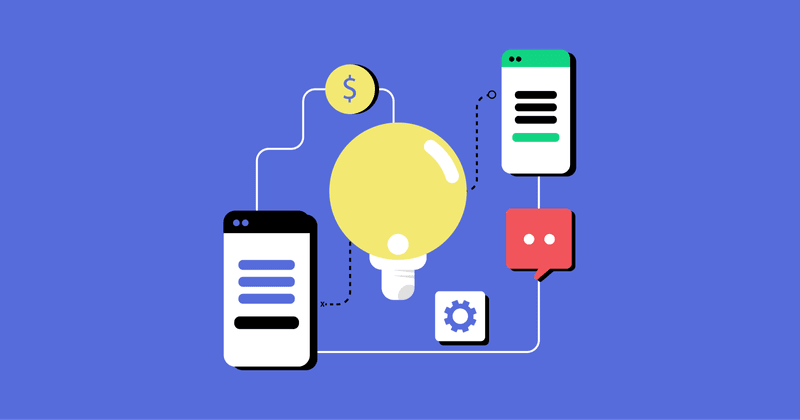How apps can innovate
Innovation isn't accidental, it's designed.

Innovation is often thought of as a spontaneous process, but this blog will dispel that myth. While new ideas can indeed appear out of nowhere, true innovation — the kind that drives businesses forward — is a process that can be learned and developed.
To start, let’s define innovation, using a definition from management consultancy McKinsey & Company:
Innovation is the ability to conceive, develop, deliver, and scale new products, services, processes, and business models for customers.
Based on this definition, you are already innovative. However, sustaining innovation requires the right culture and processes. Fortunately, we can learn from many innovative app businesses.
One such example is Welltory, a wellness app, where Asya Paloni serves as VP of Strategy. Asya views innovation as a “very organized way of researching and thinking about products.” After nearly eight years with Welltory, she has developed an innovation framework that helps the team conceptualize and prioritize new core features for the app.
In this blog, we’ll break down the pillars of Asya’s innovation framework, which she shared in a recent episode of the Sub Club podcast. While Asya notes that the framework is always evolving, it provides a solid starting point for how your app business can think about which features to build.
1. Always align to your mission
Start by getting everyone on the same page and focused on a common goal. This ensures that all efforts are synchronized and pushing in the same direction, which is crucial for innovation.
Welltory’s mission is “to improve people’s well-being with science and technology that serve each individual personally.” If a feature doesn’t explicitly improve well-being or isn’t personalized and adaptable to the individual, then it probably shouldn’t be worked on. This clarity helps the team make decisions and prioritize tasks.
At RevenueCat, we do the same. Our mission is to help developers make more money. When we prioritize our roadmap — or when I consider what new blogs and resources to work on — that mission is our guiding principle. Every team meeting starts with a reminder of this mission, helping us stay focused and aligned.
Think of it as a litmus test: if it doesn’t pass, think twice before working on it.
Aligning with your mission might seem straightforward, but as Asya points out, it’s a step that’s often skipped. Many companies get caught up in the excitement of new ideas and forget to check if those ideas align with their core purpose.
2. Visualize the specific user you’re building for
First, know your users and the segments they group into. When you’re building a feature, keep that specific or core segment in mind and consider how they would respond to this feature.
Asya shares a great example from Welltory, where their biggest user segment is affectionately referred to as “The Dude Abides,” inspired by the character from The Big Lebowski. If you’re not familiar, “The Dude” is the laid-back, easygoing protagonist of the cult classic film. Known for his relaxed attitude, often seen in a bathrobe with a White Russian in hand, and his famous line, “The Dude abides,” encapsulates his stress-free approach to life.

To bring this segment to life, Welltory uses AI-generated images of “The Dude” in various situations — whether it’s “dude at the office” or “dude on the couch.” This visualization helps the team stay focused on their primary user segment’s lifestyle and preferences. As Asya puts it, even though they have other segments like athletes or the health-anxious, they recognize that most people using their app in the evening are in a “Dude” mindset — relaxed and looking for easy, stress-free interactions.
By visualizing “The Dude” in different contexts, Welltory creates a clear, relatable image of their core user. This method helps them ensure that the features they build resonate with the majority of their users. So, when you’re developing a new feature, think about your “Dude” — who is this feature for, and how will they interact with it?
3. Specify the triggers you’re covering
The third step is identifying the triggers — those specific moments and motivations — that prompt your users to open and interact with your app.
Asya explains this well by asking: What is happening in your user’s life that makes them open your app and see your feature? Triggers can be varied. For instance, Duolingo uses an artificial trigger with its owl that chimes in, reminding users to practice. It’s a great example of an external prompt. On the other hand, apps like Uber are triggered by a practical need — the user needs to get somewhere.
For wellness apps like Welltory, understanding triggers can be more complex. Initially, users might open the app out of curiosity or to check their sleep report. However, as time goes on, those triggers evolve. Asya highlights that a year down the line, curiosity might no longer be a compelling reason. Instead, Welltory focuses on more persistent triggers like boredom or existential thoughts. They aim for users to open their app when they’re bored in line at a store or at home, just before they might typically open social media.
Without a clear trigger, even the most innovative feature can go unnoticed.
4. Know what job is to be done for the user
Finally, understand what job you’re doing for the user. This involves thinking broadly about why people download your app in the first place and what they expect it to do for them.
Asya points out that in health and wellness tech, there are no straightforward, daily “jobs to be done” because there often aren’t immediate triggers. Instead, the immediate job might simply be to alleviate boredom. However, if you consider the broader picture, there are high-level jobs that users expect your app to fulfill.
For example, a massive job to be done might be to help users have more energy to play with their kids. These meta jobs aren’t associated with immediate triggers but reflect the broader goals users have when they download your app.
In the case of Welltory, while the immediate job might be alleviating boredom, the high-level jobs include monitoring and tracking health, providing personalized insights and recommendations, facilitating behavior change, and helping users feel better overall. Users might also seek education and community support from the app.
So, when designing your app, think about both the high-level and immediate jobs to be done. By addressing both types of jobs, you can ensure your app meets user expectations and provides value on multiple levels.
How to put this framework into practice
So, how does this framework translate into the actual features you build and your approach to innovation?
Asya shares some practical insights on how to apply this framework effectively. Initially, she tried assigning points to each element of the framework — like completed triggers or covered segments — and then prioritizing features that collected the most points. While this quantifiable approach might seem logical, you can’t just score every project with a framework and expect to have the perfect backlog.
Instead, use the framework as a set of guiding principles to evaluate whether a feature is worth developing. Here are some questions to ask yourself during this process:
- Mission: Does this feature align with your company’s mission? If it doesn’t contribute to your core purpose, it might not be worth pursuing.
- Segment: Who is this feature for? Visualize your key user segment and consider how they would interact with this feature.
- Triggers: What triggers will lead users to this feature? Ensure there is a clear and compelling reason for users to engage with it.
- Jobs-to-be-done: What job does this feature do for the user? Address both the immediate and high-level needs that your users have.
The goal isn’t to create a rigid scoring system but to use these principles to guide your decision-making process. Work through these steps and you can better ensure the features you build are high impact and push your app forward.
You might also like
- Blog post
Modeling attribution on iOS: what works, what doesn’t, and how to choose
How to navigate the messy world of SKAN, AEM, and probabilistic attribution — plus two practical frameworks to get a clearer picture of campaign performance.
- Blog post
Your sprints must pay for themselves: Dan Layfield’s product advice
What’s worth building? Dan Layfield shares a 3-bucket framework to help app teams prioritize features, fix churn, and ship faster.
- Blog post
Is monetization hurting your app’s user experience?
Don’t trade short-term revenue for long-term trust. How ethical UX can still drive effective monetization.

